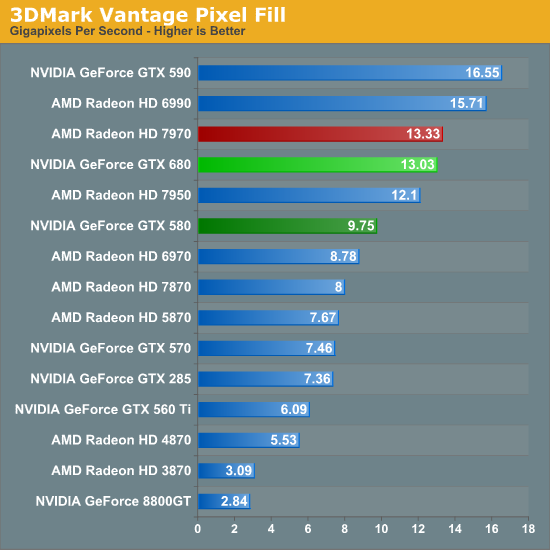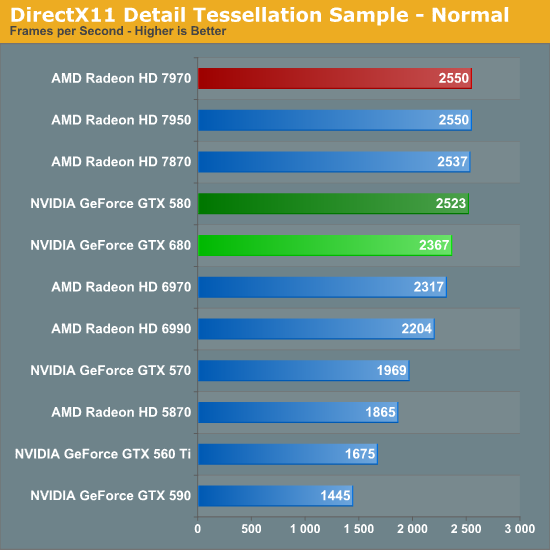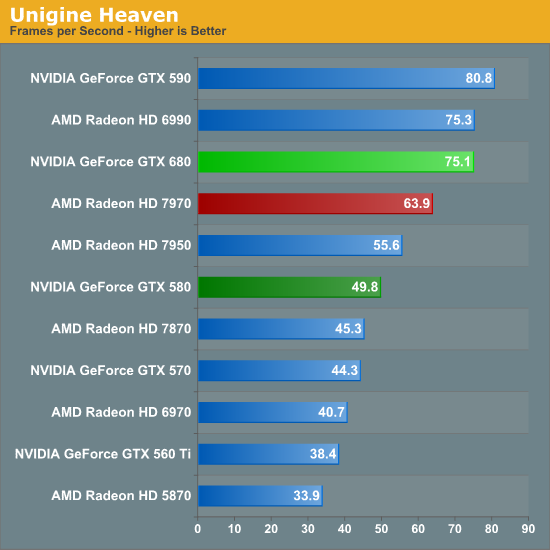NVIDIA GeForce GTX 680 Review: Retaking The Performance Crown
by Ryan Smith on March 22, 2012 9:00 AM ESTTheoreticals
As with any new architecture, we want to take a few moments to look at theoretical performance. These numbers shouldn’t be taken too seriously for cross-vendor comparison, but these numbers often tell us more about interesting architectural improvements that occur from one generation to the next.

Our first theoretical test is perhaps the most perplexing: 3DMark Vantage’s pixel fill test. Typically this test is memory bandwidth bound as the nature of the test has the ROPs pushing as many pixels as possible with as little overhead as possible, which in turn shifts the bottleneck to a mix of ROP performance and the memory bandwidth needed to feed those ROPs.
Compared to the GTX 580, the GTX 680 has almost exactly the same amount of memory bandwidth (192GB/sec) and only 86% of the theoretical ROP performance (37Gpix vs. 32Gpix). In short, it shouldn’t outperform the GTX 580 here, and yet it outperforms the 580 by 33%.
Why does it do this? That’s the hard thing to answer. As we mentioned in our look at GK104’s architecture, NVIDIA did make some minor incremental improvements to their ROPs coming from GF114, such as slightly improved compression and improved polygon merging. One of those may very well be the contributing factor, particularly the compression improvements since this is a typically memory bandwidth bottlenecked test. Alternatively, it’s interesting to note that the difference between the two video cards is almost identical to the difference in the core clock. GTX 560 Ti’s results tend to blow a hole in this theory, but it bears consideration.
In any case, it’s an interesting turn of events and hopefully one that isn’t simply an edge case. As we’ve seen in our benchmarks GTX 680 has strong performance – even if its lead compared to the 7970 diminishes with resolution – but compared to the GTX 580 in particular it needs strong ROP performance across all games in order to deliver good performance at high resolutions and anti-aliasing.

Our second theoretical test is 3DMark Vantage’s texture fill test, which to no surprise has the GTX 680 handily clobbering all prior NVIDIA cards. NVIDIA’s inclusion of 128 texture units on GK104 versus 64 on their previous generation GPUs gives the GTX 680 far better texturing performance. The 30%+ core clock difference only serves to further widen the gap.


Our third theoretical test is the set of settings we use with Microsoft’s Detail Tessellation sample program out of the DX11 SDK. Overall while NVIDIA didn’t make any significant changes to their tessellation hardware (peak triangle rate is still 4/cycle), they have been working on further improving performance at absurdly high tessellation factors. You can see some of this in action at the max factor setting, but even then we’re running into a general performance wall since the Detail Tessellation program can’t go to the absolute highest tessellation factors NVIDIA’s hardware supports.

Our final theoretical test is Unigine Heaven 2.5, a benchmark that straddles the line between a synthetic benchmark and a real-world benchmark as the engine is licensed but no notable DX11 games have been produced using it yet. In any case the Heaven benchmark is notable for its heavy use of tessellation, which means it’s largely a proxy test for tessellation performance. Here we can see the GTX 680 shoot well ahead of the GTX 580 – by more than we saw in the DX11 Detail Tessellation sample – but at the same time there’s a lot more going on in Heaven than just tessellation.
Honestly at this point in time I’m not sure just how much more tessellation performance is going to matter. Until DX11 is the baseline API for games, tessellation is still an add-on feature, which means it’s being used to add fine detail to specific models rather than being used on everything in a game world. This demands good tessellation at high factors but at the same time it’s subject to diminishing returns on the improvement to image quality as triangles reach single pixel sizes and smaller. To that end I’m still waiting to see the day where we see tessellation scale similarly to textures – that is by using full MIP chaining of displacement maps – at which point we can evaluate tessellation performance similar to texture performance when it comes to both measuring the performance hit and evaluating the difference in image quality.










404 Comments
View All Comments
_vor_ - Tuesday, March 27, 2012 - link
All I read is blah blah blah NVIDIA blah blah nerdrage blah blah.CeriseCogburn - Tuesday, March 27, 2012 - link
I'll translate for the special people that need more help.AMD's IQ has been bad since 5000 series, with 6000 series also screwey.
You will have shimmering in game textures and lines in shading transitions on screen since their algorithm has been messed up for years, even though it is angle independent and a perfect circle, IT SUCKS in real life - aka gaming.
Nvidia doesn't have this problem, and hasn't had it since before the 5000 series amd cards.
AMD's 7000 series tries once again to fix the ongoing issues, but fails in at least 2 known places, having only Dx9 support, but may have the shimmering and shading finally tackled and up to Nvidia quality, at least in one synthetic check.
_vor_ - Tuesday, March 27, 2012 - link
How much is NVIDIA paying you to babysit this discussion and zealously post?"It's better to keep quiet and people think you are a fool, than to open your mouth and prove them right."
CeriseCogburn - Tuesday, March 27, 2012 - link
Words right from anandtechs articles, and second attack.A normal person would be thankful for the information.
CeriseCogburn - Tuesday, March 27, 2012 - link
Did you notice the Nvidia card won Civ5 by more than the amd did in Metro2033, but Civ5 is declared a tie, and well we know what everyone is claiming for Metro2033.I noticed that and thought it was quite interesting how that was accomplished.
BoFox - Monday, March 26, 2012 - link
AMD's angle-independent AF is still flawed in that it's not fully trilinear when it comes to high-frequency textures (noisy moire). You'd be seeing lines of transition when everything suddenly becomes a bit blurry in a distance with these kinds of grainy textures.It's rather subjective, though.
Nvidia does offer up to 32x CSAA with TRAA (transparent, or alpha textures) in DX10/11 games for superb IQ without having to use brute-force SSAA. AMD does not currently support "forced" AAA (Adaptive AA) on alpha textures in DX10/11 games, and the SSAA support in DX10/11 games was finally announced in beta driver support form with HD 7970 cards.
Transparency AA has been around since 2005, and Nvidia actually maintained the quality IQ options for DX10/11 games compared to DX9 games all along.
ati666 - Monday, March 26, 2012 - link
did AMD fix this problem in their HD7970 or not?CeriseCogburn - Tuesday, March 27, 2012 - link
We will find out what's wrong with it a year from now when the next series big 8000 is launched, until then denials and claims it's as good as nvidia are standard operating procedure, and spinning useless theoretical notions that affect gameplay exactly zero and have amd IQ disadvantages will be spun in a good light for amd to get all the amd fans claiming the buzzwords are a win.That will work like it has for the last 3 releases, 4000, 5000, and 6000, and we just heard the 7000 series fixes that fix the 5000 and 6000 crud that was covered up until now in the 7970 release article.
So amd users will suffer bad IQ in several ways while buzzing up words that are spun from this website as notional greatness and perfectness of amd till like, next release... then your question will be answered - just try to not notice anything until then, ok ?
blanarahul - Saturday, March 24, 2012 - link
I was confused as to GPU Boost was necessary or not. Thanks for making the difference clear.ammyt - Saturday, March 24, 2012 - link
Dafuq y'all saying?The benchmarks are tight in front of your faces! The 680 is tied with the 7950, which surpasses it by a little, and the 7970 is the leader. The 7950 is cheaper by a little margin, but the 7970 is roughly $80 more expensive. What are y'all fighting for?
If I were to choose between the 680, 7950, 7970, I will choose the 7950, cheaper, and a faster by a little margin than the 680. I don't care how or why (memory clock, architecture, bla bla bla) but the benchmarks are in front of you! Clearly, anandtech is biased towards Nvidia.
(Perhaps they're getting paid from them more than AMD...)